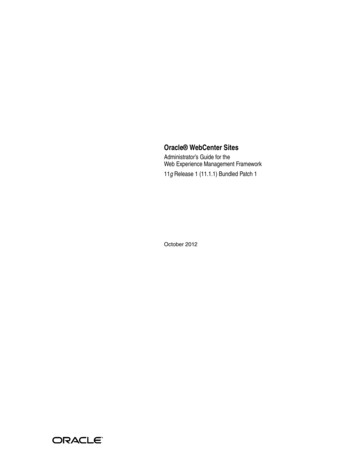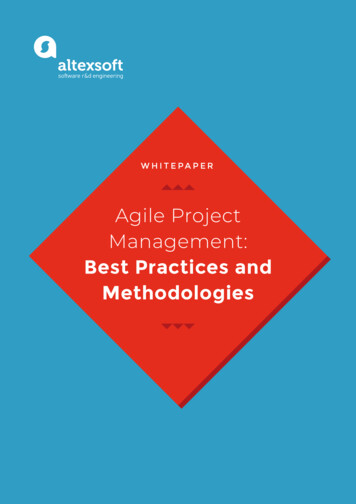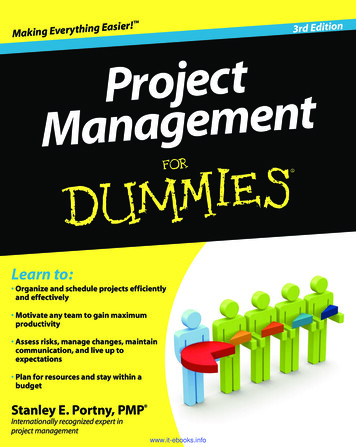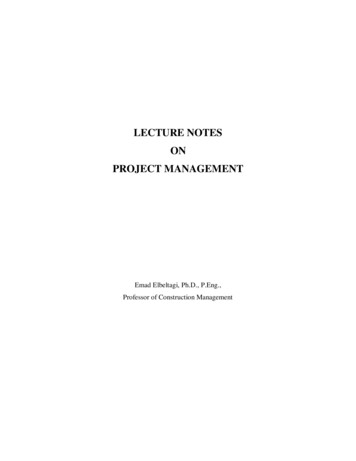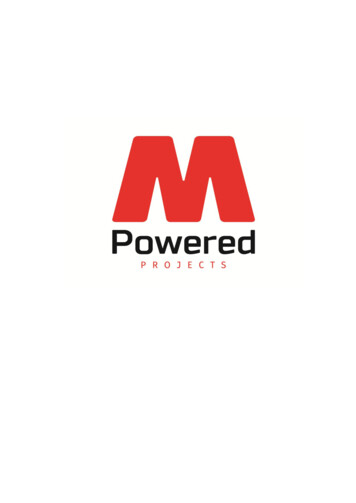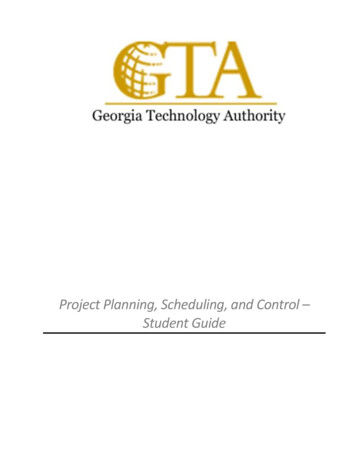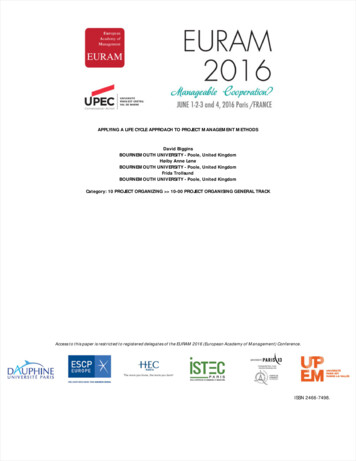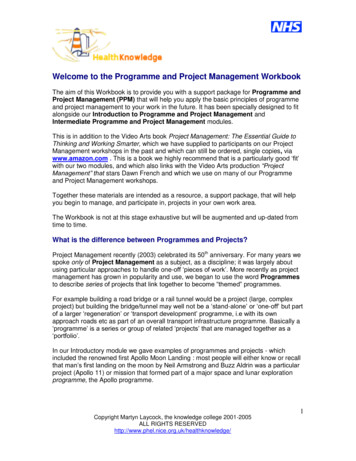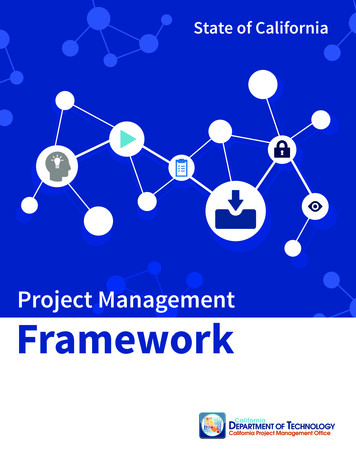
Transcription
ContentsState of CaliforniaCalifornia Department of TechnologyProject Management FrameworkProject MManagementnaggegemFrameworkPage i
ContentsCalifornia Department of TechnologyProject Management FrameworkOverview3916Overview of the CA-PMFDocument Structure and Convention GuideDiscussion of LifecyclesTemplates361314ApproachCA-PMF TemplatesAdditional TemplatesRecommended UsePage ii
ContentsCalifornia Department of TechnologyProject Management FrameworkConcept316ApproachProcess Phase ChecklistInitiating323323842ApproachProject CharterStakeholder RegisterRACI MatrixProcess Phase ChecklistPage iii
ContentsCalifornia Department of TechnologyProject Management FrameworkPlanning4333640182ApproachComplexity AssessmentProject Management Plan (PMP)Plans Subordinate to the PMPProcess Phase ChecklistExecuting3273134ApproachDeliverable Expectation DocumentsSurveysProcess Phase ChecklistPage iv
ContentsCalifornia Department of TechnologyProject Management FrameworkClosing31419ApproachLessons LearnedProcess Phase ChecklistAdditional Resources324122125ApproachFramework ResourcesFramework ReferencesGlossaryPage v
California Department of TechnologyDocument ControlProject Management FrameworkVersion HistoryDocument history and version control is used to record detail of minor andmajor changes to the California Project Management Framework (CA-PMF).Version #DateAuthorChanges1.05.02.2016CDTInitial Publication1.15.13.2016CDTMinor Edits1.26.24.2016CDTMinor Edits2.07.18.2017CDTUpdated content to incorporate user centeredbest practices, updated PAL information,updated PMLC reference to OrganizationalChange Management (OCM) and BusinessProcess Reengineering (BPR), and minor edits.2.14.15.2018CDTUpdated content to incorporate A Guide tothe Project Management Body of Knowledge(PMBOK Guide) 6th edition, updated PALinformation, and minor edits.Page vi
California Department of TechnologyProject Management FrameworkOverviewThis chapter provides an overview of theCalifornia Project Management Framework,its purpose and use, and how it will help youwith your projects.Overview Page 1
California Department of TechnologyOverviewProject Management FrameworkIn this chapter.123Overview ofthe CA-PMFDocumentStructure andConventionGuideDiscussionof LifecyclesPage 3Page 9Page 161.1 Purpose andUse of theFramework2.1 Colors and IconConventions1.2 Varying ProjectSizes andComplexity2.3 Key NavigationElements1.3 The Value of theCA-PMF1.4 A ThoughtfulApproachto ProjectManagement2.2 Chapters2.4 Call-Out Boxes3.1 ProjectManagementLifecycle (PMLC)3.2 SystemDevelopmentLifecycle (SDLC)3.3 Project ApprovalLifecycle (PAL)3.4 RelationshipBetweenLifecyclesOverview Page 2
Overview1California Department of TechnologyProject Management FrameworkOverview of the CA-PMFPageThe California Project Management Office (CA-PMO) has designed the CaliforniaProject Management Framework (Framework or CA-PMF) to provide Californiaorganizations with a solid foundation for project success. This new Frameworkreplaces the project management guidance and tools that were previouslyincluded in the California Project Management Methodology (CA-PMM).The CA-PMF offers guidance and insight on project management methodsand approach (through the use of resources, tools, and templates), as wellas narratives detailing the justifications for why specific activities shouldbe performed. Icons, colors, and other graphic elements throughout theFramework are intended to promote ease of use.1.1 Purpose and Use of theFrameworkThe CA-PMF is a practical and useful guide to lead a Project Manager and teamthrough the Project Management Lifecycle (PMLC) for projects of all sizes, so thatthey achieve expected outcomes and thereby project success. The Frameworkfocuses on Information Technology (IT) projects, but it can be used by projectteams for other types of projects as well.The Framework highlights important project management priorities. Itoffers recommended practices and lessons learned regarding method andapproach (through the use of resources, tools, and templates). The Frameworksupports project management practices that conform to industry standardsas defined by the Project Management Institute (PMI) and adapted to thecontext of California State government. For deep dives into a particular projectmanagement discipline discussed in the CA-PMF, refer to PMI’s A Guide to theProject Management Body of Knowledge (PMBOK Guide).The intended audience for the Framework is Project Managers and project teampractitioners who are responsible for directly performing or overseeing projectmanagement processes and activities, however, the CA-PMF also containsuseful information for Project Sponsors, project participants, and Stakeholdersregarding the effective and efficient management of projects. The guidance andOverview Page 3
OverviewCalifornia Department of TechnologyProject Management Frameworkadvice contained in the Framework emphasizes the importance of people skills,good judgment, and effective communications in the successful delivery ofprojects. These are critically important and relevant to all project Stakeholders.The Framework includes all major project processes and activities, from initialproject definition to project closing. This will equip the Project Manager with thetools necessary to consider the needs of the project and how its organizationcan be structured and managed to deliver the intended result.The Framework also provides models for the management tools and plansused to document and manage the project. Project management practitionersare encouraged to leverage the tools and templates by modifying them for theneeds of their respective projects. Each plan describes some aspect of how theproject team conducts its work. This includes how to control the operation ofthe project team, assess project progress, and evaluate the quality of productscreated by the project.The CA-PMF aligns with state policy, identifies the connections to the projectoversight and project approval processes, and directs practitioners to theappropriate resources for further information on those processes.A key objective of the CA-PMO is to keep the Framework relevant over time byupdating it with additional guidance and tools as they become available for thestate’s project management community to leverage in future projects. This isone of the reasons that the CA-PMF included templates under the broader term“tools”; because although many of the CA-PMF tools are currently templates,a range of different kinds of tools will be added to the CA-PMF toolset overtime. This objective also highlights the importance of state Project Managersand teams having easily available and current reference material for projectmanagement.1.2 Varying Project Sizes andComplexityInformation technology projects vary in size, type, and complexity. Sponsoringorganizations embark on projects with varying levels of project skills, experienceand process maturity. A project may impact a small number of Stakeholders, orit can affect the lives of millions.No matter what a project’s size or complexity, the project management objectiveto work through each project management discipline is consistent. For example,not every project needs a stand-alone governance plan. As long as the ProjectManager includes a clear description of how decisions will be made in the ProjectOverview Page 4
OverviewCalifornia Department of TechnologyProject Management FrameworkManagement Plan (PMP), the project management objective of documentinga governance process is met. The Project Manager and project team shouldaddress all of the industry standard project management disciplines, but at thesame time adjust the level of complexity and rigor to match the needs of theindividual project. The CA-PMF framework provides guidance and adaptabilityfor what is required relative to each project management discipline.The Framework focuses on a product development and service deliveryapproach that follows a traditional waterfall methodology, which is presentlythe predominant methodology used by the state for projects. However, the useof an iterative or adaptive lifecycle strategy, such as Agile development, stillrequires the Project Manager and the project team to work through the projectmanagement disciplines and determine how the processes should be adaptedto the needs of the development approach. To help with this adaptation, the CAPMF includes guidance on what types of projects are suited for an Agile deliveryapproach, how to assess the readiness of organizations for an Agile deliveryeffort, and recommended practices related to Agile. An ongoing developmenteffort will provide guidance for how the Framework elements can be adaptedfor efforts that use an Agile delivery approach.1.3 The Value of the CA-PMFAs projects vary, so does the training and experience of Project Managers.However, regardless of the Project Manager or project team experience,the Framework is intended to offer an opportunity for the state’s projectmanagement community to strive for a level of efficiency and consistency inthe way projects are managed.The Framework provides a number of benefits, including:1. A project management “how-to” guide for Project Managers and projectteams across a range of experience levels, using practical language thatis easy to understand and use.2. A project management framework, nomenclature, and toolset withtemplates, examples, and instructions that are flexible to accountfor differences in project needs, but are structured to be consistentlyapplicable across a wide range of project types, sizes, and complexities.3. Guidance that is compliant with current project management standardsand policies, and is based on industry best practice and lessons learned.4. A statewide project management perspective that addresses therelationships between high level project activities, the project approvalprocess, procurement activities, and system development activities.Overview Page 5
OverviewCalifornia Department of TechnologyProject Management Framework1.4 A Thoughtful Approach toProject ManagementThe Framework is a standards-based guide that includes all of the key elementsa Project Manager needs to consider for success. However, he or she mustadjust their use of the Framework to the specific conditions and needs of eachproject undertaken. This is why the soft skills and good judgment of the ProjectSponsor, Project Manager, and project team members are key ingredientsfor successful project management. Good project management consists ofequal parts science, good judgment, and people skills, including effectivecommunication, as indicated in Figure 1-1.The Framework provides much of the science of project management in theform of a sound process for project teams to follow. It offers a set of useful toolsand techniques to provide a structured, disciplined, and repeatable approachto project management based on industry standards and best practices.These components provide the foundation for project success. However,project management is more than building a schedule, assigning tasks, andmonitoring progress. Project management is about communicating effectivelywith Stakeholders, finding solutions within given constraints, continuouslyimproving, and adding value to the organization and users by addressing theneeds of the business.Proper use of the CA-PMF tools and techniques will help make success morelikely. However, the ultimate success of a project depends on the experience,skills, and sound judgment of the Project Manager, project team, and the ProjectSponsor, as they are responsible for ensuring that the work is completed andall project pieces come together as planned. Since delivering project outcomesis usually a team effort, people skills and effective communication are keyinputs for success. In any project, the unexpected will happen and risks willbecome issues. Success comes to those who exercise good judgment as theyanticipate and plan for these possibilities, deal with issues as they arise, andwork effectively as a cohesive team.Every project team consists of a group of people enlisted to work togethertowards a common goal. In managing any project team, the Project Manager hasto communicate a clear vision and a plan for the work. He or she also needs toensure that the work is progressing as scheduled and that the plan is adapted tonew and changing information. The Project Manager should diligently developa collaborative relationship with all Stakeholders that stresses objectivity,balance, and support. The objective is to provide focus, daily management, andproactive communication to help ensure the success of the project.Overview Page 6
California Department of TechnologyOverviewProject Management FrameworkSound ProcessA project management framework offers project teams auniform set of supportive processes, tools, and techniquesfor achieving valued project results.Good JudgmentPositive project results depend on good judgment byproject leadership as the project team navigates projectrisks and complexities.People SkillsProject teams consist of groups of people enlisted towork together towards a common project goal. A ProjectManager’s people skills are essential to guiding projectteams to successful outcomes.Effective CommunicationProficient project team management relies on effectivecommunication from the Project Manager, as he orshe enlists action by conveying the project’s strategic,operational and tactical elements, and promotes progressand accomplishment.Figure 1-11.4.1 Incorporating a User-CenteredApproachSuccessful projects traditionally have been judged on whether they deliver theplanned scope (everything the project promised to do), are on time, and stayon budget. But scope, time and budget aren’t the only way to judge the successof a project. For example, scope, time and budget do not measure whether acompleted project successfully makes a task simpler, clearer, and faster for auser.Because of this, successful private and public sector projects now prioritizemaking sure that the needs of users are understood and met. This shifts the focusof project delivery from merely meeting a pre-determined set of requirements,to delivering technology that helps people get their jobs done more simply,effectively, and quickly.Overview Page 7
OverviewCalifornia Department of TechnologyProject Management FrameworkConsidering and meeting user needs increases the likelihood that the projectwill achieve its objectives. New techniques and practices have been added tothe traditional project management processes described in the CA-PMF to helpproject teams better understand and meet user needs throughout the projectmanagement lifecycle (PMLC).Gathering requirements is often an upfront project activity that involves manyusers and collecting and sorting a lot of feedback in a short period of time.Projects can be more successful by regularly and frequently talking with usersabout their requirements throughout the project. This is also known as ongoinguser research. This approach allows for requirements that are gathered at thestart of the process to become better understood and refined over time as theteam works with users to better understand and deliver those user requirements.An evolving understanding of what users need means more time can be spenton ensuring that what is being developed will work for them.Keeping user needs in the forefront also should significantly improve howproject decisions are made. Understanding user needs provides context anddirection to the various options presented during a project. Decisions can thenbe made based upon data about what will deliver the most value to users.Another feature of a user-centered approach is to deliver working productsas fast as possible. Doing so requires the project team to use the idea ofincremental or modular delivery that focuses on taking the project’s overallscope and breaking it into smaller pieces, or modules. Each module will deliverfunctionality in a periodic or continuous manner, prioritized by what providesthe highest value to the user. This approach reduces the time between projectstart and when users have value in hand, in contrast to the “Big Bang” approachwhere all functionality is provided at the end.Through this user-centered and continuous approach to delivery, project teamshave more frequent opportunities to learn and improve from module to moduleand release to release.Note: A blue bar in the margin has been added to version 2.0 of the CA-PMF thatdenotes newly incorporated user-centered concepts.Overview Page 8
Overview2California Department of TechnologyProject Management FrameworkDocument Structure and Convention GuidePageThis section of the Framework describes its structure and the conventionsused to present information. Graphic elements, including icons, strategic useof color, and call-out boxes, are used to clearly communicate practical projectmanagement concepts, as well as engage the reader’s attention and improveinformation retention. The structure of the CA-PMF also organizes informationinto digestible portions through the use of chapters, lifecycles, and keynavigation elements to guide the reader through the document.2.1 Colors and IconConventionsEach chapter of the CA-PMF is identified with a specific color and distinct icon.Those chapters that correspond to process phases of the PMLC follow the colorused to denote the process phase. These chapter colors and icons are presentedat the beginning of each chapter and then continue throughout each page ofthe chapter, as a bold visual reference within the page header. The color gray isused for this first process phase of the PMLC and is distinct from its blue-coloredcounterparts to indicate that these Concept Process Phase activities take placebefore the formal PMLC defined by PMBOK.Additional icons and colors are employed to distinguish between each of theother lifecycles referenced within the CA-PMF. The methodical use of color isdesigned to help project managers more quickly and easily navigate the CAPMF document.Overview Page 9
California Department of TechnologyOverviewProject Management FrameworkIcons used throughout this framework are shown by grouping for your reference:Project ManagementLifecycleSystem anningDesignExecutingBuildClosingTestMonitoring &ControllingImplementMaintenance &OperationsOverviewTemplatesAdditional ResourcesOverview Page 10
California Department of TechnologyOverviewProject Management FrameworkRecommendedPracticesProject Approval LifecycleRolesStage 1ProcessesStage 2ActivitiesStage 3ToolsStage 4OutputsInputsSkillsOverview Page 11
OverviewCalifornia Department of TechnologyProject Management Framework2.2 ChaptersThe CA-PMF is comprised of eight chapters. The use of chapters is intendedto group content into logical domains, helping make the information easilyaccessible as you navigate the document. The eight chapters of the CA-PMFinclude:OverviewThis introductory chapter provides an introduction to the CA-PMF,its purpose and use, and how it can help you with your projects.It shows how the Framework is structured with specific icons andcolors for ease of navigation. It also offers a high-level overview ofthe lifecycles that are part of the Framework.TemplatesThis chapter contains information about the collection of templatesthat are available as part of the CA-PMF to help a project teamcomplete a project. Two versions of templates are available. Theyare, “templates with instructions,” which provide guidance andsample text, and “template shells,” which can be used by thosewho don’t require/desire much instruction or are more experiencedproject teams or team members.ConceptThis chapter guides project teams through the development of astrong business case. This chapter also provides an overview of theother activities that should take place before formally initiating aproject.InitiatingThis chapter provides guidance and tools to ensure that project staff,the business organization, and external Stakeholders understandwhat is being undertaken, what to expect as the project takes shape,and what are each group’s roles and responsibilities to promoteproject success. At this time methods are established for monitoringand controlling the project.Overview Page 12
OverviewCalifornia Department of TechnologyProject Management FrameworkPlanningThis chapter helps guide completion of essential project planning.It demonstrates how to estimate and establish the scope of work,define and refine the project objectives, and develop the courseof actions to attain those objectives. At this point in the ProjectManagement Lifecycle (PMLC) the project team will begin creatingproject documents that identify all of the processes and activitiesnecessary to successfully deliver the expected project outcomes.ExecutingThis chapter describes the implementation of the projectdocumentation that was developed earlier in the project. The teamfocuses on the production and quality of team deliverables, andensures that the work is completed with the right level of disciplineand rigor to reduce project risks and meet quality standards.ClosingThis chapter provides guidance for accepting and transferring theproduct to the support organization, or suspending or canceling theproject. The team assesses the project to develop lessons learnedand recommended practices to be applied to future projects.Additional ResourcesThis chapter provides resources to support the Framework and tiesinto other California Department of Technology (CDT) processes orproject management lifecycles. This chapter also contains links toinformation about traditional System Development Lifecycle (SDLC)and Agile delivery approaches.Overview Page 13
OverviewCalifornia Department of TechnologyProject Management Framework2.3 Key Navigation ElementsThe CA-PMF contains six categories of information to help Project Managersnavigate the PMLC. The categories include:Recommended PracticesTechniques or methods that, through experience and research, areproven to reliably achieve a desired result.RolesResponsibilities for project Stakeholders, including a list of key rolesassociated with the process phase activities.ProcessesSteps or procedures for the project team to follow.ActivitiesActions or activities for project team to undertake.ToolsTemplates or other resources to help create project outputs.Templates are documents that have been pre-developed for use onyour project. There are two styles of templates: those that containinstructions and those that are just the template shells.OutputsWork products that are developed.The Process graphics included in the CA-PMF reference the following twoadditional categories of information:InputsInformation and documents that feed into a process.SkillsSpecial or unique human expertise that should be applied to achievea successful project outcome.Overview Page 14
California Department of TechnologyOverviewProject Management Framework2.4 Call-Out BoxesThroughout the Framework, “call-out” boxes are used to bring attention toinformation that further supports the narrative guidance. These graphics havebeen integrated into the document to highlight useful information at a glance.Examples of how call-out boxes are used include: Categories within each phase of the Project Management Lifecycle(navigation elements: recommended practices to consider, roles involved,processes to follow, activities to undertake, tools available for assistance,and outputs to create) Skills that are helpful for a particular process Website links or other references for additional information Guidance on when to use a tool based on project complexity Quotes and tips that are called-out for greater emphasis Recommended practices that promote a user-centered approachRecommendedPracticesReview RecommendedPractices as you developthe Project Charter.ToolsRolesFor a complete list ofall project roles seethe Project Roles andDefinitions in the Glossary.OutputsFor a complete list of allproject Tools that areincluded in the CA-PMF seethe Templates chapter.Draft Stage 1 BusinessAnalysis.LMAlign the project conceptwith the sponsoringorganization’s priorities.SkillsFacilitation skills are keyfor effective meetings.ActivitiesSchedule enough time toproperly conduct projectplanning activities.iWeb Link/ InfoSee the StateAdministrativeManual (SAM) formore information onprocurements.User-CenteredApproachWhen to Use?Use the template forprojects of the followingcomplexities:ProcessesWhen the project purposeand desired outcomes arevague, the risk of projectscope creep is very high.This recommendedpractice promotes a usercentered approach.HOverview Page 15
Overview3California Department of TechnologyProject Management FrameworkDiscussion of LifecyclesPageThe CA-PMF PMLC is a model for managing all activities associated with a projectfrom inception to completion. During the delivery of IT projects, the PMLC andthe System Development Lifecycle (SDLC) are tightly integrated and must besimultaneously managed. The successful management of each lifecycle cangreatly affect the other, and both directly determine the level of success ofthe overall project. Additionally, California has adopted the Project ApprovalLifecycle (PAL) to improve the quality, value, and likelihood of success fortechnology projects undertaken by the State of California. The PAL is intendedto ensure projects are undertaken with clear business objectives, accuratecosts, and realistic schedules.iFor More Info.See the AdditionalResources chapter forhow the CA-PMF relatesto other lifecycles andprocesses.While the CA-PMF describes interactions with state policy, PAL, and SDLC, itdoes not focus on these interactions. Rather, the CA-PMF focuses on providingactionable guidance related to the PMLC, and linking project teams to existingstate policy, PAL, and SDLC resources.3.1 Project ManagementLifecycle (PMLC)The PMLC refers to a series of activities that are necessary to fulfill project goalsor objectives. Projects vary in size, complexity, and type, but all projects can bemapped to the PMLC structure no matter how large or small. It is designed to beflexible, allowing it to accommodate projects that vary in size and complexity aswell as the project team’s experience. This takes into account that the range ofactivities a project team should undertake to successfully deliver a project willvary from project to project.As shown in Figure 3-1, the purpose of following a PMLC is to create a repeatableprocess for managing projects that delivers significant value to the businessand supports the organization’s strategic goals and objectives. Within thePMLC, there are iterative groups of processes that a project team navigates tocomplete the project. The CA-PMF refers to PMBOK’s process groups as processphases. The five CA-PMF process phases include: Concept, Initiating, Planning,Executing, and Closing. Monitoring and Controlling is also referenced as acollection of processes that occur throughout the project to maintain quality.Overview Page 16
California Department of TechnologyOverviewConceptInitiatingThoughtfulwork done priorto formallyinitiating aproject.Identification andestablishment ofexpected projectobjectives, roles,and outcomes.Project Management FrameworkPlanningOrganization, preparation, definition,and refinement of how objectives andoutcomes will be achieved.ExecutingProducts and results designed andproduced to deliver expectedproject outcomes.ClosingEvaluationandconclusion ofprojectoutcomes andactivities.Monitoring & ControllingContinuous tracking, assessment and coordination to adjust project performance for maintaining alignmentwith project objectives.Figure 3-1Project Management LifecycleThe PMLC is a series of phases to ensure management and controlover a project. During each phase, processes, activities, and toolsare used to fulfill project goals or objectives. The PMLC is designedto accommodate projects that vary in size and complexity.Process Phases in the Project Management LifecycleConceptThe Concept Process Phase encourages smart thinking, an openmind, and thoughtful work done prior to formally initiating a project.Long-term project success requires a healthy dose of optimism anda “can do” attitude, combined with the ability to confront challengesthat present themselves during the course of a project.InitiatingIdentification and establishment of expected project objectives,roles and outcomes. The Initiating Process Phase shows howcreating a good foundation leads towards project success. Theproject staff, business organization, and external Stakeholders mustunderstand what is being undertaken, what to expect as the projecttakes shape, and what are each group’s roles and responsibilities.In this process phase, the project is formally initiated through thecompletion of the Project Charter.Overview Page 17
OverviewCalifornia Department of TechnologyProject Management FrameworkPlanningOrganization, preparation, definition, and refinement of howobjectives and outcomes will be achieved. The Planning ProcessPhase helps guide successful completion of essential projectplanning. Here, you will estimate and establish the scope of work,define and refine the project objectives, develop the course ofactions to attain those objectives, and establish methods formanaging and controlling the project.ExecutingProducts and results designed and produced to deliver expectedproject outcomes. In the Executing Process Phase, the project teamwill be guided to execute tasks and generate deliverables describedin the project documentation. The team is guided to pay particularattention to the production and quality of team deliverables, and toensure that work is completed with the right level of discipline andrigor to reduce project
the Project Management Body of Knowledge (PMBOK Guide) 6th edition, updated PAL information, and minor edits. California Department of Technology. Project Management Framework. Overview Page 1. . Project Management Framework (Framework or CA-PMF) to provide California organizations with a solid foundation

